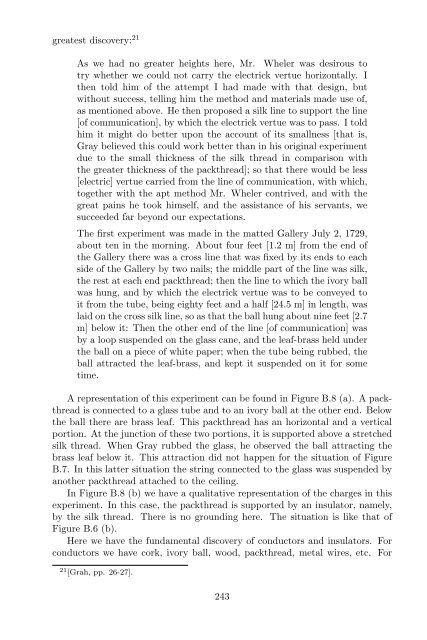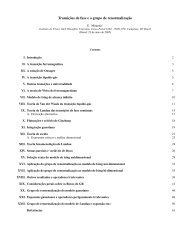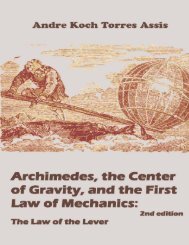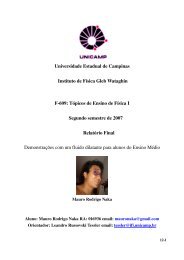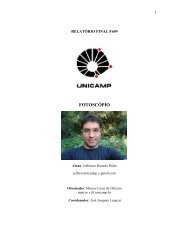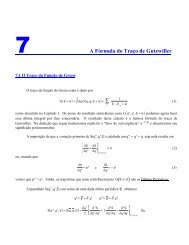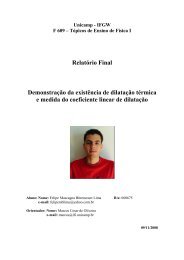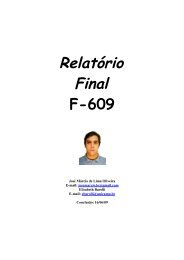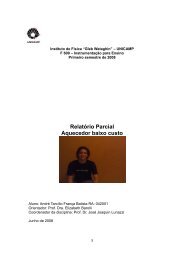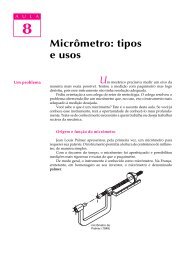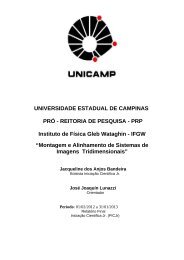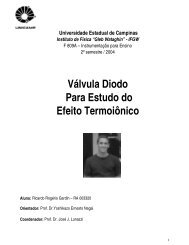The Experimental and Historical Foundations of Electricity - Unicamp
The Experimental and Historical Foundations of Electricity - Unicamp
The Experimental and Historical Foundations of Electricity - Unicamp
You also want an ePaper? Increase the reach of your titles
YUMPU automatically turns print PDFs into web optimized ePapers that Google loves.
greatest discovery: 21<br />
As we had no greater heights here, Mr. Wheler was desirous to<br />
try whether we could not carry the electrick vertue horizontally. I<br />
then told him <strong>of</strong> the attempt I had made with that design, but<br />
without success, telling him the method <strong>and</strong> materials made use <strong>of</strong>,<br />
as mentioned above. He then proposed a silk line to support the line<br />
[<strong>of</strong> communication], by which the electrick vertue was to pass. I told<br />
him it might do better upon the account <strong>of</strong> its smallness [that is,<br />
Gray believed this could work better than in his original experiment<br />
due to the small thickness <strong>of</strong> the silk thread in comparison with<br />
the greater thickness <strong>of</strong> the packthread]; so that there would be less<br />
[electric] vertue carried from the line <strong>of</strong> communication, with which,<br />
together with the apt method Mr. Wheler contrived, <strong>and</strong> with the<br />
great pains he took himself, <strong>and</strong> the assistance <strong>of</strong> his servants, we<br />
succeeded far beyond our expectations.<br />
<strong>The</strong> first experiment was made in the matted Gallery July 2, 1729,<br />
about ten in the morning. About four feet [1.2 m] from the end <strong>of</strong><br />
the Gallery there was a cross line that was fixed by its ends to each<br />
side <strong>of</strong> the Gallery by two nails; the middle part <strong>of</strong> the line was silk,<br />
the rest at each end packthread; then the line to which the ivory ball<br />
was hung, <strong>and</strong> by which the electrick vertue was to be conveyed to<br />
it from the tube, being eighty feet <strong>and</strong> a half [24.5 m] in length, was<br />
laidonthecrosssilkline, soasthat theball hungaboutninefeet[2.7<br />
m] below it: <strong>The</strong>n the other end <strong>of</strong> the line [<strong>of</strong> communication] was<br />
by a loop suspended on the glass cane, <strong>and</strong> the leaf-brass held under<br />
the ball on a piece <strong>of</strong> white paper; when the tube being rubbed, the<br />
ball attracted the leaf-brass, <strong>and</strong> kept it suspended on it for some<br />
time.<br />
A representation <strong>of</strong> this experiment can be found in Figure B.8 (a). A packthread<br />
is connected to a glass tube <strong>and</strong> to an ivory ball at the other end. Below<br />
the ball there are brass leaf. This packthread has an horizontal <strong>and</strong> a vertical<br />
portion. At the junction <strong>of</strong> these two portions, it is supported above a stretched<br />
silk thread. When Gray rubbed the glass, he observed the ball attracting the<br />
brass leaf below it. This attraction did not happen for the situation <strong>of</strong> Figure<br />
B.7. In this latter situation the string connected to the glass was suspended by<br />
another packthread attached to the ceiling.<br />
In Figure B.8 (b) we have a qualitative representation <strong>of</strong> the charges in this<br />
experiment. In this case, the packthread is supported by an insulator, namely,<br />
by the silk thread. <strong>The</strong>re is no grounding here. <strong>The</strong> situation is like that <strong>of</strong><br />
Figure B.6 (b).<br />
Here we have the fundamental discovery <strong>of</strong> conductors <strong>and</strong> insulators. For<br />
conductors we have cork, ivory ball, wood, packthread, metal wires, etc. For<br />
21 [Grah, pp. 26-27].<br />
243


